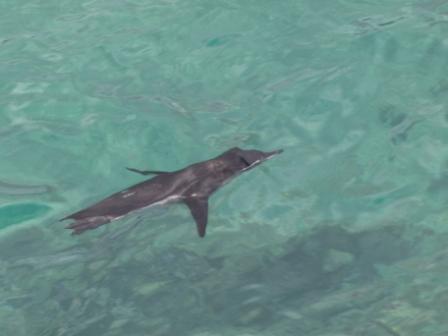Fwd: Visit Galapagos? - a Galapagos primer

VulcanSpirit
Richard & Alison Brunstrom
Mon 9 Apr 2012 05:15
You might be thinking of coming here, so here are a few helpful hints - we knew nothing when we arrived and had to learn the hard way. We wish we had planned more in advance.
This is first and foremost a wildlife activity holiday destination - and the activities are highly structured. There is very limited opportunity to lie on a beach (thank goodness) and almost no scope to explore on your own. There is no indigenous population - the 'local people' (there are now about 20 000 of them) exist purely and simply to support the tourist trade which is growing exponentially (literally, I've seen the graphs). Galapagos tourism is Ecuador's second biggest foreign currency earner, after oil, and it has to be said they do it rather well. The main town, Puerto Ayora, is very pleasant and actually has lots of goods for sale that you'd want to buy as a momento of your trip!
Most of the archipelago (part of Ecuador since 1832) is a National Park, and very highly regulated. To protect the Park public access is totally banned almost everywhere, except to designated visitor sites in the company of an accredited local Guide. There are a couple of worthwhile short trips to do yourself from Puerto Ayora (with loads of wildlife - there are sealions on the dinghy dock, and marine iguanas walking under the tables in the seaside restaurants, and a truly lovely beach) but they occupy only a day or two. Really you need to go on trips - either the lengthy range of day trips (at about $150pp per day) or short residential boat trips for which you will pay anything from $500 for a last minute three day cheapo trip (like us next week) to several thousand dollars for eight days on a first class boat. And there are diving trips - day or residential, and mixed diving/land tours - but all done by boat. You can organise all this from the UK or wherever, or on site here (but easier if you don't carelessly time your arrival for the Easter holidays as some foolish boaters have done).
It is impossible to see everything - there's just too much, and as usual with wildlife some of the stuff is really difficult to get to: the most interesting (to me at least) giant tortoises live on the top of five 1500 metre volcanoes (one species per volcano!) on the island of Isabela (which is entirely wild and over 100 miles long, straddling the equator) and simply cannot be visited. And we'd hoped to see active volcanoes close up - but it just can't be done (go to Hawai'i instead).
But never mind: what can be seen is amazing - mindblowing, if you are even a little interested in evolution. And happiness is guaranteed - you will see lots of fantastic wildlife, up close like nowhere else on earth.
I'll illustrate this in future Blogs, but here is a taster from our first trip out, to the small island of Bartolome located to the southeast of Santiago:
This first shot gives a good idea of the volcanic geography:
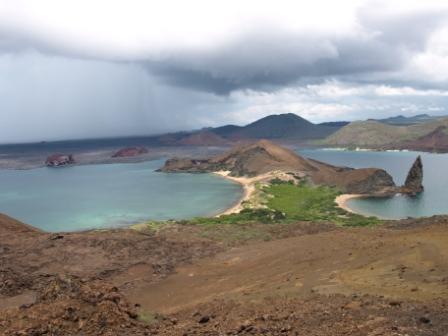
We're looking west(ish) from Bartolome across to Santiago in the distance. Bartolome is volcanic and about 1.2 million years old, but the flat grey rocks on the left centreground are lava from the 1894 eruption on Santiago - notice that there are two red "islands" sticking out of it. They are old weathered lava and truly were islands until 1894, surrounded by 20m seas. Recent basalt is black or dark grey; it weathers to red because of the presence of iron within it. These islands are very arid (although this is what passes for the wet season, and you can see a rain shower on the left in the distance). Other islands are much more lush, particularly at high level. Because of the low rainfall and absence of frosts and high winds erosion on land is negligible - look at this landscape:

It looks like the moon. The small craters are exactly that - cinder cones. They are over a million years old but look as if they finished erupting last week. There is almost no vegetation, but there is life:
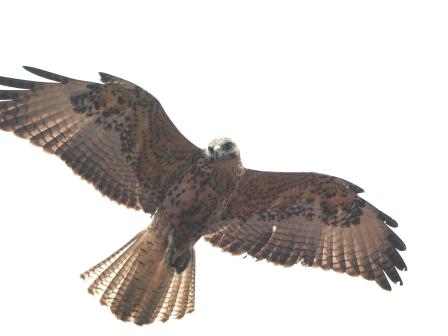
This guy is a young Galapagos hawk Buteo galapagoensis - in UK terms, a buzzard (the same genus as our UK species), endemic to Galapagos, and he's spending his day soaring on the thermals over Bartolome and snacking on the odd lava lizard. DNA studies reveal it to be closely related to Swainson's hawk which breeds throughout North America and makes an enormous migration to Argentina each year. About 125000 years ago (yesterday in geological terms) a small group of migrating Swainson's hawk must have been blown off course, landed in Galapagos and stayed. They are now the islands' top predator. It has subsequently become more sedentary, and movements between islands are now rare - further speciation is on the way!
The Galapagos hawk is a most unusual bird. On some islands it practices cooperative polyandry - one female establishes a breeding group with up to eight males whose behaviour she closely controls with a range of vocalisations. These voluntary groups are stable from year to year, but raise only one, or at most two, chicks so most of the males are simply helping out without breeding. But on other islands different more 'normal' breeding arrangements are seen. Why, we don't yet know. But something with which to break the ice at parties perhaps, as long as you don't want to be invited back.
These completely wild birds (no feeding or touching allowed) show no fear of humans and will land close:

Indeed, they are both friendly and inquisitive, and take a real interest in visitors, landing as here on the handrail in front of our group - this one actually tried to land on a friend's head to her great surprise as she didn't see it coming:
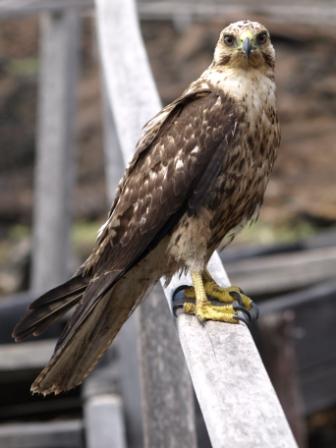
And thereby enabling some really fabulous close-ups:
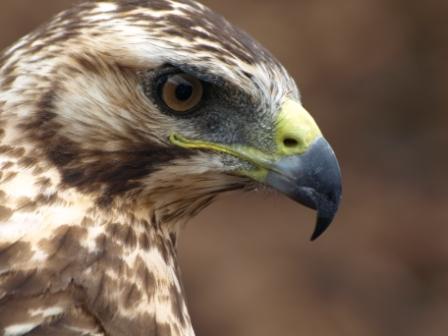
But that's not all for this short trip. On the way back to the boat we fsaw Galapagos penguins Spheniscus mendiculus:
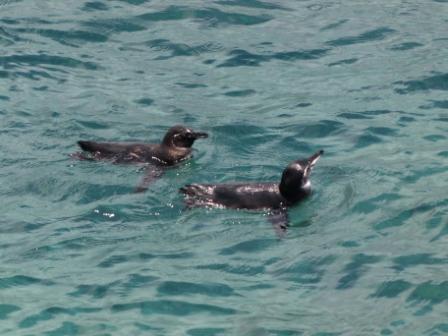
Penguins are birds of the far south. These are closely related to Humboldt's penguin of Chile, and presumably originally arrived here on the cold north-flowing Humboldt current up the west coast of South America. There are only just over a thousand of them (they've never been numerous, even before the arrival of humans) and their very exposed to extinction by disease, either natural or introduced by man, as malaria devastated the endemic birds of Hawai'i. But at the moment they're still here, and looking beautiful as they 'fly' through the water, as streamlined and as fast as a sealion. Birds lose their wings when they don't need to fly. Flying is very energy intensive, and if you don't need to fly to catch food or escape predators then there's no point. That's why there are or ued to be, before humans, lots of flightless birds on islands. Galapagos still has a flightless cormorant whose ancestors must have flown here (but we won't get to go where it lives, so no pictures). But I was talking today to a guy who'd been swimming with them this week and they were pecking at the front of his underwater camera lens and generally showing off.
Convinced yet? Possibly not - but hopefully future Blog posts will tip the balance.
